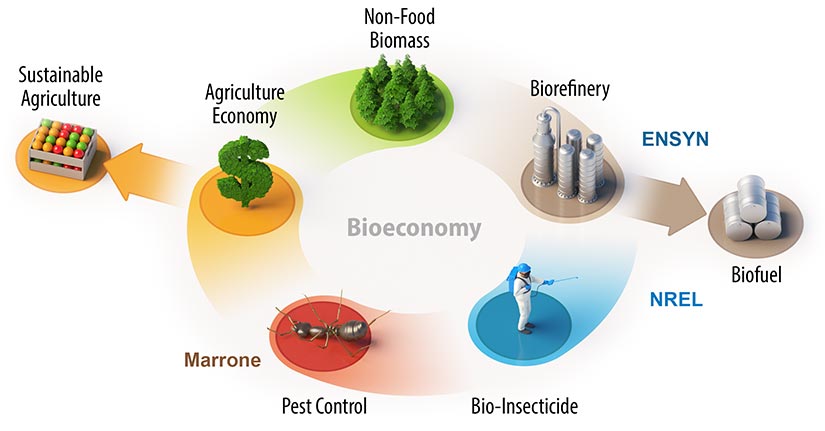Unleash Your Business Potential with Biomass-Based Innovations
Introduction to Biomass-Based Innovations
What Does Biomass-Based Mean?
Biomass-based innovations refer to the development and use of technologies and processes that harness the energy and resources contained in organic materials. These organcic materials are derived from living organisms, such as plants and animals.

How is it Relevant To Businesses
Biomass-based innovations are important for businesses because they offer:
Technological Advancements:
- Staying at the forefront of biomass technology advancements can lead to more efficient and cost-effective energy solutions.
- This would give businesses a competitive edge on energy efficiency, production quality, and operational excellence.
Market Positioning:
- Being an early adopter of biomass-based innovations can set a business apart in the market.
- It allows companies to position themselves as industry leaders and pioneers in sustainable practices.
- This would attract environmentally conscious customers and partners.
Business Diversification:
- Biomass innovations open up opportunities for diversification and revenue generation.
- It is especially in sectors related to biomass production, processing, and technology development.
- This diversification can contribute to business growth and resilience.
These innovations can be used for various energy needs, like heating, electricity, and biofuels. They help companies reduce their carbon footprint and manage waste effectively. This makes them more environmentally responsible.
Biomass innovations also allow businesses to become less dependent on fossil fuels. They provide opportunities for new businesses in the biomass industry and can lead to job creation. But this can be expensive and unstable. As technology improves, biomass energy becomes more efficient and cost-effective.
Economic Benefits and Cost Savings
Embracing biomass-based innovations offers significant economic advantages for businesses and industries. These advantages include:
Cost Savings:
- Biomass technology is often more cost-effective than traditional fossil fuel production.
- It requires less capital investment and lower operating costs.
- This makes it a financially attractive option for businesses.
- By utilizing waste materials for energy production, companies can reduce waste disposal costs.
- This could further contribute to cost savings.
Revenue Generation:
- Biomass technology provides opportunities for revenue generation by converting waste materials into a valuable energy source.
- Industries that produce significant waste, such as agriculture, forestry, and manufacturing, can turn their waste into a profitable resource.
- This extra revenue stream enhances financial sustainability.
Access to Government Incentives:
- Governments around the world promote adopting renewable energy sources, including biomass.
- Businesses that embrace biomass-based innovations may qualify for various incentives, grants, and tax benefits.
- These incentives can offset initial investment costs and reduce the financial burden of transitioning to biomass energy.
- Thus making it a financially viable choice.
Long-Term Financial Sustainability:
- Biomass is a renewable energy source.
- This ensures a stable and consistent energy supply over the long term.
- Businesses can avoid the price fluctuations and supply problems linked to finite fossil fuels.
- This happens when they reduce their dependency on these resources.
- This long-term energy security enhances financial sustainability and mitigates financial risks related to energy production.
Environmental Benefits:
- While not directly financial, it's worth noting that biomass innovations also offer indirect economic advantages.
- This is by reducing the environmental impact of industries.
- This can result in cost savings by reducing expenses for following environmental rules and avoiding fines related to emissions and waste management.

Case Studies and Success Stories
There are real-world examples of businesses that have successfully integrated biomass-based innovations into their operations. At the same time they show practical benefits and results achieved. Some examples are:
Drax Group (United Kingdom):
Integration: Drax Group is a UK-based renewable energy company. They have successfully integrated biomass into their operations. It transformed their coal power station in North Yorkshire into one of the largest biomass power plants in the world.
Benefits: Drax Group's conversion to biomass significantly reduced its carbon emissions and played a vital role in the UK's renewable energy generation. The company aims to be carbon-negative by 2030 through Bioenergy with Carbon Capture and Storage (BECCS) technology.
Challenges: The main challenge faced was the transition from coal to biomass. As this required extensive modifications to the power station.
Results: Drax's biomass operations have become a cornerstone of the UK's renewable energy sector. They now supply clean electricity to millions of homes and businesses.

Renewable Energy Group (REG) (United States):
Integration: REG is a global producer of renewable fuels. They specialize in biodiesel production from biomass sources like soybean oil.
Benefits: REG's innovative biodiesel production has reduced carbon emissions and dependence on fossil fuels. This makes them a leader in the biofuels industry. By producing biodiesel, REG contributes to a more sustainable transportation sector.
Challenges: Scaling up biodiesel production and ensuring a consistent supply of biomass feedstock were some of the challenges.
Results: REG is now one of the largest biodiesel producers in the United States. They now contribute to cleaner transportation and reduced greenhouse gas emissions.

Enviva (United States):
Integration: Enviva is the world's largest manufacturer of sustainable wood pellets. They play a crucial role in providing biomass as an alternative to coal in power generation.
Benefits: Enviva's wood pellets have replaced coal in power plants. Thus, reducing carbon emissions and supporting a transition to sustainable renewable energy.
Challenges: The challenges included making sure there was always enough wood biomass available and modifying coal plants to use biomass as fuel.
Results: Enviva's innovative approach has significantly contributed to the reduction of coal consumption and the adoption of cleaner energy sources.

These examples showcase how businesses have successfully integrated biomass-based innovations into their operations. This resulted in reduced carbon emissions, cleaner energy generation, and a better balance of eco-friendly energy sources. While challenges exist, these companies have demonstrated the practical benefits of biomass in reducing environmental impact and contributing to the fight against climate change.
Implementing Biomass-Based Innovations
Getting started with biomass-based innovations involves several key steps to ensure a successful transition to this renewable energy source:
Feasibility Assessment:
Begin by conducting a thorough feasibility assessment. This is to determine if biomass-based innovations align with your business goals and resources. Consider factors such as energy requirements, available land or facilities, and budget constraints. Check the environmental and economic benefits of biomass energy for your specific operations.
Identify Suitable Biomass Sources:
Identify and assess potential biomass sources in your region. These may include agricultural residues (e.g., crop waste, straw), forestry by-products (e.g., wood chips, sawdust), or organic waste (e.g., food scraps, manure). Consider the availability and sustainability of these biomass sources to ensure a long-term supply.
Select the Right Technology or Approach:
Research and choose the appropriate biomass conversion technology based on your biomass source and energy needs. Common methods include direct combustion, gasification, pyrolysis, or biofuel production. Consult with biomass energy experts or technology providers to determine the most suitable approach for your business.
Assess Regulatory and Logistical Challenges:
Investigate local and national regulations related to biomass energy production, emissions, and waste management. Ensure compliance with environmental and safety standards.
Address logistical challenges, such as, biomass transportation, storage, and handling. Develop efficient logistics plans to cut disruptions to your operations.
Secure Financing and Incentives:
Explore available financing options, grants, and incentives for biomass projects. Government programs and renewable energy incentives can help offset initial investment costs.
Work with financial experts to create a budget and secure the necessary funding for your biomass-based innovations.
Conclusion
In conclusion, embracing biomass-based innovations offers businesses many advantages, including technological progress, competitive market positioning, economic benefits, and long-term financial stability. These innovations lead to cost savings and revenue generation. But they also grant access to government incentives, reduce carbon footprints, and create opportunities for growth.
Real-world examples like Drax Group, Renewable Energy Group (REG), and Enviva prove the tangible benefits of biomass adoption. To get started, businesses should follow structured steps.
Which are from feasibility assessments to securing financing, ensuring a seamless transition to biomass energy while contributing to environmental responsibility and a more sustainable energy landscape. By embracing biomass-based innovations, businesses can pioneer sustainability and drive positive change in the fight against climate change.


